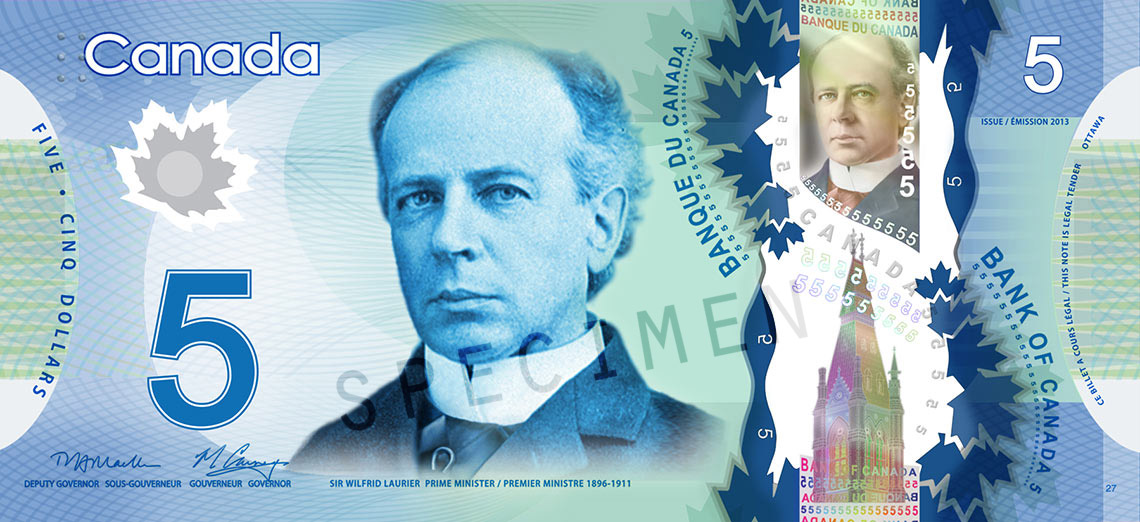
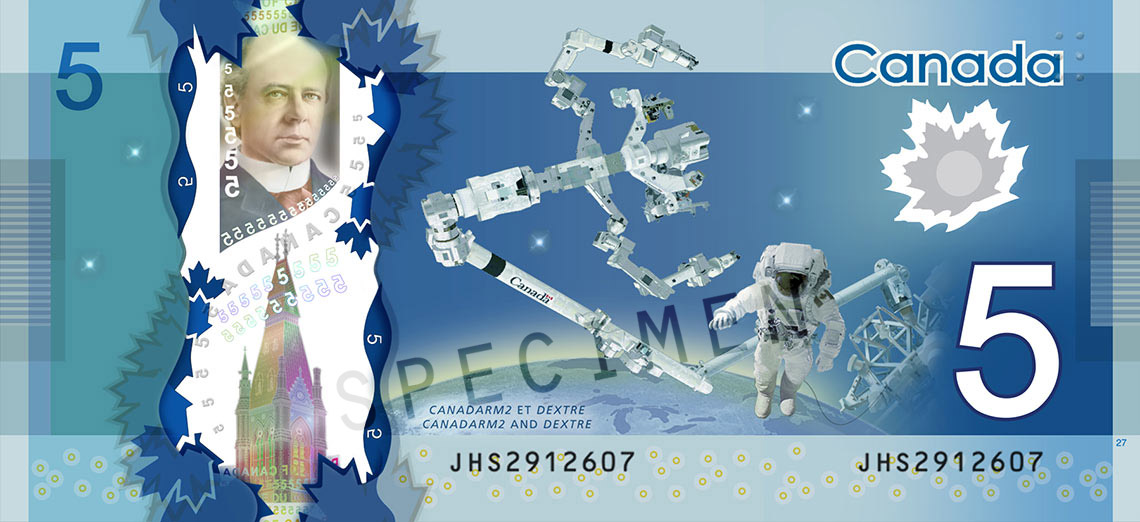
Robotics innovation is Canada’s ongoing contribution to the International Space Station program and demonstrates our commitment to space exploration. The Canadian-built Mobile Servicing System is the sophisticated robotics suite that helped to assemble the International Space Station in orbit. This system consists of Canadarm2, Dextre and the Mobile Base. On board the space station—a permanent orbiting research laboratory—international partners conduct scientific experiments, many of which result in an enhanced quality of life on earth. Canada’s contribution to the space program evokes pride and sparks the imagination and curiosity of our future leaders in science and technology.

The portrait

Feel the raised ink
The portrait of Sir Wilfrid Laurier (Prime Minister, 1896-1911) is based on a photograph from Library and Archives Canada. Laurier was elected to the House of Commons in 1874. He remained a Member of Parliament for 45 consecutive years and was leader of the Liberal Party for 32 of them. Laurier was Canada’s first francophone Prime Minister. He was a master in the art of constructive compromise and a passionate advocate of national unity. His governments promoted national development and expansion, encouraging immigration from Europe and the United States to Western Canada; supporting the construction of a second transcontinental railway; and overseeing the incorporation into the country of two provinces, Alberta and Saskatchewan, as well as the Yukon Territory.
The smaller metallic portrait of Laurier in the large window of the $5 note was colourized for adaptation as a holographic feature.

The building

Look at the metallic building. Tilt to see it change colour. Flip to see it on the other side
The West Block of Parliament’s original construction was completed in 1865 and the building opened in 1866. The West Block’s most distinctive tower is depicted on the $5 note. The Mackenzie Tower is named for Alexander Mackenzie, Canada’s second Prime Minister (from 1873–1878). Designed by Thomas Stent and Augustus Laver, the tower was erected over the West Block in 1878, capping a new wing added to accommodate the needs of the growing public service.

Mobile Servicing System: Canadarm2, Dextre and the Mobile Base
Canada’s contribution to the International Space Station (ISS) program is its expertise in robotics. On the ISS, Canadarm2 is the 17-metre-long robotic arm that plays a major role in the assembly and maintenance of the station. It is frequently mated to Dextre, which is short for Special Purpose Dexterous Manipulator. This two-armed robot sometimes referred to as the "Canada Hand" acts as the station’s outdoor handyman. Canadarm2 and Dextre are mounted on a moveable work platform and storage facility called the Mobile Base.

Astronaut
The astronaut featured on the $5 note represents all Canadians who have contributed to the space program and the research conducted on board the International Space Station. The details of the astronaut’s spacesuit have been simplified for the size of a bank note, and with the exception of the Canadian flag patch, the image is void of any identifying mission or rank markers.

Earth
The depiction of Earth from space was based on satellite images provided to the Bank by Natural Resources Canada. The Great Lakes, Hudson Bay and the Gulf of St Lawrence make the view of Canada easily recognizable.
As the Earth appears in the lower portion of the note, you cannot see all of Canada. Because of the limited space on a bank note, and in order to include a denomination’s various design elements, they must overlap to a certain extent. For the Polymer series, a total of three maps are shown on the notes: this depiction of Earth from space as well as maps on the $10 and $50 notes. And though you cannot see Canada’s northernmost borders or Quebec on the $10, the obscured areas of that map are deliberately highlighted on the map featured on the $50 note and vice versa.

Stars
The stars featured on this bank note are not a known constellation, but an artistic rendering of five stars to represent the $5 denomination.
Did you know that there are over 1.5 billion Canadian bank notes in circulation? In fact, if you stacked them all together they’d reach a height of over 150 kilometres. That’s officially outer space!
Additional security features
Feel the raised ink on the large number.
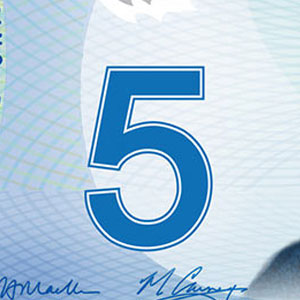
Look at the frosted maple leaf window to see its transparent outline.
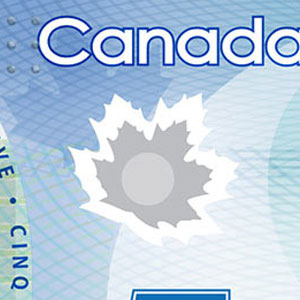
Feel the raised ink on the words "Banque du Canada" and "Bank of Canada".
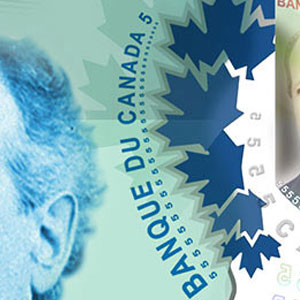
Look at the numbers that match the note’s value and at the word "Canada" that feels slightly raised.
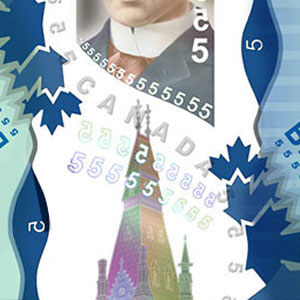
Look at the metallic portrait, it matches the large portrait. Tilt to see it change colour. Flip to see it on the other side.
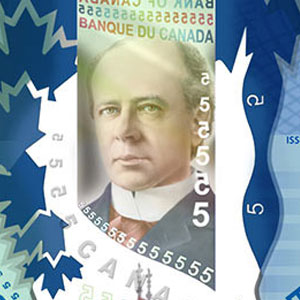
Look for maple leaves that border and cross into the large window.
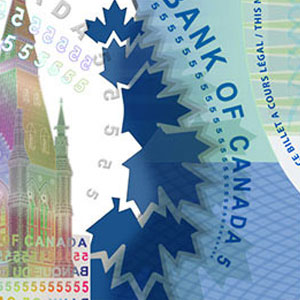
Bank note specifics
- Portrait: Sir Wilfrid Laurier, Prime Minister, 1896–1911
- Building: The West Block of Parliament
- Signatures: Left - T. Macklem, Right - M.J. Carney / Left - T. Macklem, Right - Stephen S. Poloz / Left - Carolyn A. Wilkins, Right - Stephen S. Poloz / Left – Carolyn A. Wilkins, Right – T. Macklem / Left – Carolyn Rogers, Right – T. Macklem
- Size: 152.4 x 69.85 mm (6.0 x 2.75 inches)
- Issue date: 7 November 2013
- Theme: Canadarm2 and Dextre
For more information, visit the Canadian Space Agency.